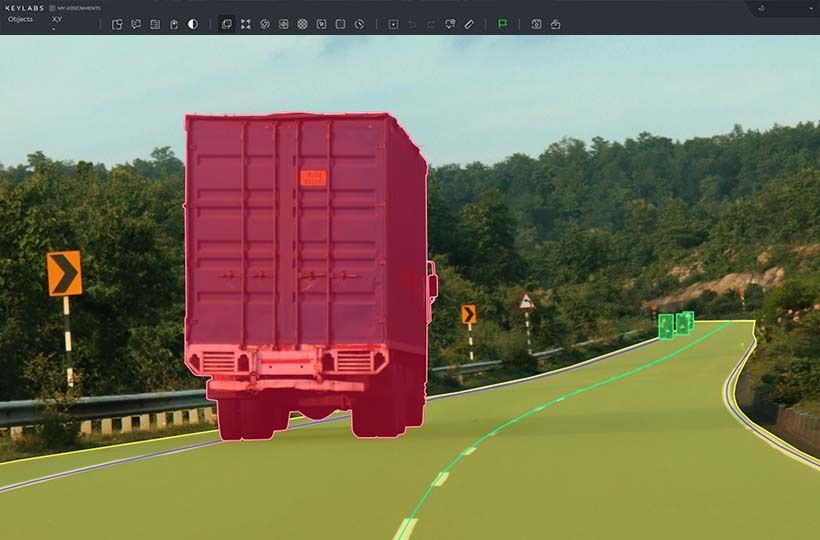How to Choose the Right Data Annotation Tool in 2025
Choosing the right annotation platform in 2025 depends on what feels practical for your team and project. With so many labeling tools and AI annotation software options, getting lost in features and promises is easy. In most cases, the best fit is the one that works smoothly with your existing machine learning tools and doesn't slow down your process.
Key Takeaways
- Project success hinges on aligning platform capabilities with team workflows.
- AI-assisted features now handle repetitive tasks without sacrificing accuracy.
- Scalability impacts long-term costs more than upfront pricing models.
- Compliance features are non-negotiable for regulated industries.
- Real-time collaboration tools prevent bottlenecks in distributed teams.
- Integration with existing infrastructure reduces implementation friction.

Overview of Data Annotation and Its Impact on AI
Data annotation is essential in preparing data for AI and machine learning projects. Annotation platforms provide the structure to turn raw data into useful information through precise labeling. As machine learning tools become more advanced, the demand for accurate and scalable data labeling platforms continues to grow.
Poorly annotated data can lead to flawed models, while well-executed annotation improves accuracy and reduces bias. Choosing the correct data labeling platforms can speed up development and make it easier to maintain data quality over time.
The Evolution of Data Annotation Tools
Data annotation tools have evolved significantly over the years to keep pace with the growing complexity of AI projects. Early labeling tools were often manual and time-consuming, limiting the speed at which datasets could be prepared. Today, annotation platforms incorporate automation, collaboration features, and advanced AI annotation software to streamline the process. As a result, modern data labeling platforms offer more flexibility and scalability than ever.
The shift towards cloud-based and integrated annotation solutions reflects the changing needs of AI development teams. Annotation tool comparison now often focuses on ease of use, customization, and support for diverse data types such as images, text, and video.
From Isolated Workstations to Connected Ecosystems
Early labeling tools required individual annotators to work independently, making scaling difficult and introducing inconsistencies. Today's annotation platforms combine diverse teams, AI annotation software, and machine learning tools within integrated environments. With cloud-based data labeling platforms, organizations can handle larger volumes of data, multiple data types, and complex workflows more efficiently than ever.
These connected ecosystems also promote transparency and flexibility by enabling annotators, project managers, and engineers to communicate directly through the platform. Integration with broader AI pipelines means that labeled data flows directly into training systems, reducing delays and errors. As a result, teams can rapidly iterate on datasets and respond to evolving project needs.
Intelligent Systems Redefining Possibilities
Modern AI annotation software now leverages machine learning and automation to reduce repetitive tasks and improve accuracy. These innovative capabilities allow labeling tools to focus human effort where it matters most, improving efficiency and quality.
Intelligent annotation solutions also adapt to different data types and complex scenarios, from natural language to computer vision. These systems can learn from past annotations and improve over time by integrating with advanced machine learning tools.
Understanding the Data Annotation Process
- Data Collection. The first step involves gathering raw data from various sources, such as images, text, audio, or video, for training AI models.
- Task Definition. Clear guidelines define what needs to be labeled and how, ensuring consistency across annotators and platforms.
- Annotation. Using labeling tools or AI annotation software, annotators add meaningful tags or labels to the data based on the predefined instructions.
- Quality Control. Annotation solutions include review steps to check for accuracy and consistency, often involving automated checks and manual verification.
- Integration. The labeled data is then integrated with machine learning tools to train and improve AI models, forming a continuous feedback loop for refinement.
Essential Criteria for Annotation Tool Efficiency and Functionality
When evaluating annotation platforms, several key factors determine how well they support the data labeling process. First, ease of use is crucial; labeling tools should have intuitive interfaces that minimize annotator training time. Next, flexibility matters; AI annotation software must handle various data types like images, text, and video without compromising performance. Scalability is another crucial aspect, ensuring the platform can efficiently manage growing datasets and larger teams.
Efficiency, User Interface, and Hotkey Support
Efficiency is a top priority for any annotation platform, as it directly impacts how quickly and accurately data can be labeled. A clean, well-designed user interface in labeling tools helps reduce mistakes and speeds up the learning curve for annotators. AI annotation software that includes customizable hotkey support allows users to perform everyday actions without switching tools or menus, saving valuable time.
Output Formats and Compatibility
Standard export formats like JSON, XML, COCO, Pascal VOC, and CSV cover most use cases across computer vision, natural language processing, and other AI domains. Advanced labeling tools also offer customizable output options, allowing teams to define the structure and detail level required for their specific training pipelines.
Seamless connection with data management systems, model training environments, and quality assurance workflows reduces manual data handling and potential errors. Some AI annotation software supports API access and direct syncing with cloud storage or ML frameworks, enabling real-time updates and continuous training.

Evaluating Annotation Tool Features for 2025
In 2025, evaluating annotation platforms requires a close look at how well their features address AI projects' increasing complexity and scale. Modern labeling tools must handle various data types beyond traditional images and text, including video streams, 3D point clouds, audio, and sensor data. AI annotation software with intelligent automation features such as auto-labeling, predictive tagging, and active learning helps reduce manual workloads while improving consistency across large datasets.
Another critical feature set involves quality assurance. Annotation solutions increasingly integrate automated quality checks, conflict resolution workflows, and metrics dashboards to monitor real-time accuracy. This reduces the need for constant manual oversight and helps maintain high standards throughout the labeling process. Flexibility and customization options allow teams to tailor workflows to their specific use cases, whether it's for medical imaging, autonomous vehicles, or natural language processing.
Smart Automation in Modern Labeling Systems
AI annotation software now includes features like auto-labeling, where the system predicts and applies labels based on previously learned patterns, drastically reducing manual effort. Active learning is another automation technique that prioritizes the most valuable or uncertain data points for human review, speeding up the overall process while maintaining accuracy. These automation tools work alongside labeling tools to help teams handle larger datasets faster and with fewer errors.
Beyond speeding up annotation, intelligent automation also supports continuous improvement by learning from corrections and feedback. This adaptive behavior means that AI annotation software becomes more accurate over time, reducing repetitive work and enabling annotators to focus on complex cases. Integration with quality control features ensures that automated labels meet standards before being finalized.
Pipeline Connectivity Essentials
In 2025, seamless pipeline connectivity is a must-have feature for any effective annotation platform. Data labeling platforms must integrate smoothly with existing machine learning tools, data storage systems, and model training environments. This integration minimizes manual data transfers, reduces errors, and speeds up the entire AI development cycle. Annotation solutions often provide APIs, webhooks, or direct cloud storage connections to enable real-time syncing and automated workflows.
Data Annotation Tool Selection: Key Criteria for Success
- Support for Multiple Data Types. The tool should handle various formats, such as images, video, text, audio, and 3D data, to meet diverse project needs.
- Ease of Use. An intuitive user interface and smooth workflow help reduce training time and increase annotator productivity.
- Automation Features. Capabilities like auto-labeling, active learning, and predictive tagging can speed up the annotation process and improve consistency.
- Collaboration and Access Control. Support for multiple users, role-based permissions, and version control enables efficient team workflows and data security.
- Quality Control Tools. Built-in review systems, automated quality checks, and metrics dashboards help maintain high annotation accuracy.
- Integration and Pipeline Connectivity. APIs and cloud integrations ensure smooth data flow between annotation platforms and machine learning tools.
- Customizable Output Formats. Flexible export options allow datasets to fit specific training requirements and AI pipelines.
- Scalability. The platform should efficiently support growing datasets and larger annotation teams without performance loss.
- Cost and Licensing. Transparent pricing and licensing options should align with project budgets and expected usage.
- Customer Support and Updates. Reliable technical support and regular software updates help keep the annotation platform running smoothly.
Summary
Choosing the right data annotation platforms in 2025 means carefully considering a combination of features that enhance productivity and data quality. Effective annotation platforms support diverse data types, including images, video, text, and 3D data, while providing intuitive user interfaces that make labeling easier and faster. Automation features such as auto-labeling and active learning reduce manual work and help maintain consistency across large datasets. Collaboration tools within annotation platforms enable teams to collaborate smoothly with clear role management and quality control processes. Integrating existing machine learning tools and flexible output formats ensures annotation platforms fit seamlessly into AI pipelines. Scalability, cost-effectiveness, and reliable customer support are essential to keep projects running smoothly as they grow.
FAQ
What are annotation platforms used for?
Annotation platforms help label raw data to prepare it for training AI models. They support various data types and improve machine learning tools' ability to understand information.
Why is automation critical in AI annotation software?
Automation reduces manual effort by predicting labels and prioritizing data points. This speeds up the annotation process and improves consistency across datasets.
How do labeling tools support collaboration?
Labeling tools offer features like role-based access and version control, allowing multiple users to work simultaneously. This ensures smooth teamwork and data quality.
What types of data do data labeling platforms typically support?
Data labeling platforms usually handle images, video, text, audio, and 3D data. Supporting multiple types helps address diverse AI project needs.
Why is output format flexibility crucial in annotation solutions?
Flexible output formats ensure compatibility with different machine learning tools and workflows, making integration easier and speeding up model training.
What role does quality control play in annotation platforms?
Quality control features like automated checks and manual reviews maintain annotation accuracy, help prevent errors, and improve dataset reliability.
How does pipeline connectivity benefit AI development?
Pipeline connectivity enables smooth data flow between annotation platforms and machine learning tools. It reduces manual handoffs and speeds up the AI development cycle.
What should teams look for in the user interface of labeling tools?
Teams should choose labeling tools with intuitive, easy-to-navigate interfaces. This reduces training time and increases annotator efficiency.
Why is integration with machine learning tools necessary for annotation solutions?
Integration ensures that annotated data flows seamlessly into training environments. This minimizes delays and helps keep AI projects on track.
